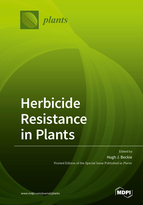Herbicide Resistance in Plants
A special issue of Plants (ISSN 2223-7747). This special issue belongs to the section "Plant Protection and Biotic Interactions".
Deadline for manuscript submissions: closed (31 December 2019) | Viewed by 76664
Special Issue Editor
Interests: herbicide resistance; herbicide-resistant crops; herbicide-resistant weeds; integrated weed management; transgenic crops
Special Issue Information
Dear Colleagues,
Relentless evolution of herbicide-resistant (HR) weeds is an important global issue, with implications for food security and economic, agronomic, and environmental sustainability. The introduction of glyphosate-resistant crops in 1996 heralded a new level of weed control over the next 10 years but was followed by increasing evolution of glyphosate-resistant weeds. Today, the alarming occurrence of multiple resistance in weed populations concomitant with the paucity of herbicides over the past 30 years with a major new mode of action has led to increasing reliance on combined—or stacked—trait HR crops to manage these populations. This Special Issue of Plants will highlight global trends in the occurrence of HR weeds; recent developments in target-site and non-target-site resistance mechanisms; population genetics/genomics of HR weeds; potential implications of genome/gene editing for weed management; fitness of HR weeds and implications for management; recent developments in HR weed management including socio-economic considerations for enhancing grower adoption; and current status and future outlook for HR traits in cereal, oilseed, and annual/perennial legume crops.
Prof. Hugh J. Beckie
Guest Editor
Manuscript Submission Information
Manuscripts should be submitted online at www.mdpi.com by registering and logging in to this website. Once you are registered, click here to go to the submission form. Manuscripts can be submitted until the deadline. All submissions that pass pre-check are peer-reviewed. Accepted papers will be published continuously in the journal (as soon as accepted) and will be listed together on the special issue website. Research articles, review articles as well as short communications are invited. For planned papers, a title and short abstract (about 100 words) can be sent to the Editorial Office for announcement on this website.
Submitted manuscripts should not have been published previously, nor be under consideration for publication elsewhere (except conference proceedings papers). All manuscripts are thoroughly refereed through a single-blind peer-review process. A guide for authors and other relevant information for submission of manuscripts is available on the Instructions for Authors page. Plants is an international peer-reviewed open access semimonthly journal published by MDPI.
Please visit the Instructions for Authors page before submitting a manuscript. The Article Processing Charge (APC) for publication in this open access journal is 2700 CHF (Swiss Francs). Submitted papers should be well formatted and use good English. Authors may use MDPI's English editing service prior to publication or during author revisions.
Keywords
- genetically modified crops
- herbicide resistance
- herbicide-resistant crops
- herbicide-resistant weeds
- integrated weed management
- transgenic crops







